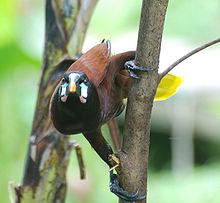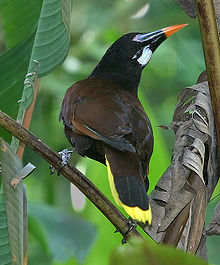- Montezuma Oropendola
-
Montezuma Oropendola 

male, illustrates brown back Conservation status Scientific classification Kingdom: Animalia Phylum: Chordata Class: Aves Order: Passeriformes Family: Icteridae Genus: Psarocolius Species: P. montezumai Binomial name Psarocolius montezuma
(Lesson, 1830)
Synonyms Gymnostinops montezuma
The Montezuma Oropendola, Psarocolius montezuma, is a New World tropical icterid bird. It is a resident breeder in the Caribbean coastal lowlands from southeastern Mexico to central Panama, but is absent from El Salvador and southern Guatemala. It also occurs on the Pacific slope of Nicaragua and Honduras and northwestern Costa Rica. It is among the oropendola species sometimes separated in the genus Gymnostinops. The English and scientific names of this species commemorate the Aztec emperor Moctezuma II.
The sexes are very different in size; the male is 50 cm long and weighs 520 g; the smaller female is 38 cm long and weighs 230 g.
Adult males are mainly chestnut with a blackish head and rump, and a tail which is bright yellow apart from two dark central feathers. There is a bare blue cheek patch and a pink wattle, the iris is brown, and the long bill is black at the base with a red tip. Females are similar, but smaller than males with a smaller wattle. Young birds are duller than adults and have a paler and less demarcated bill. No subspecies are currently recognized.
The "unforgettable" (Howell and Webb 1995) song of the male Montezuma Oropendola is given during the bowing display, and consists of a conversational bubbling followed by loud gurgles, tic-tic-glik-glak-GLUUuuuuu. Both sexes have loud cack and crrrk calls.
Although the Chestnut-headed Oropendola shares much of this species's range, it is smaller, mainly black with a chestnut head (instead of mainly chestnut with a blackish head), and lacks coloured facial patches, so the two oropendolas are unlikely to be confused.
The Montezuma Oropendola is a quite common bird in parts of its range, often seen in small or larger flocks foraging in trees for small vertebrates, large insects, nectar, and fruit, including bananas, Cecropia spikes, Gumbo-limbo (Bursera simaruba) and Trophis racemosa (Moraceae)[1]. Outside the breeding season, this species is quite mobile, with some seasonal movements.
The Montezuma Oropendola inhabits forest canopy, edges and old plantations. It is a colonial breeder which builds a hanging woven nest of fibres and vines, 60–180 cm long, high in a tree. Each colony has a dominant male, which mates with most of the females following an elaborate bowing display. The female lays two dark-spotted white or buff eggs which hatch in 15 days; the young fledge in 30. There are typically about 30 nests in a colony, but up to 172 have been recorded.
Footnotes
- ^ Foster (2007)
References
- BirdLife International (2004). Psarocolius montezuma. 2006. IUCN Red List of Threatened Species. IUCN 2006. www.iucnredlist.org. Retrieved on 21 April 2007. Database entry includes justification for why this species is of least concern
- Foster, Mercedes S. (2007): The potential of fruiting trees to enhance converted habitats for migrating birds in southern Mexico. Bird Conservation International 17(1): 45-61. doi:10.1017/S0959270906000554 PDF fulltext
- Howell, Steven N. G. & Webb, Sophie (1995): A Guide to the Birds of Mexico and Northern Central America. Oxford University Press, Oxford & New York. ISBN 0-19-854012-4
- Jaramillo, Alvaro & Burke, Peter (1999): New World Blackbirds. Christopher Helm, London. ISBN 0-7136-4333-1
- Stiles, F. Gary & Skutch, Alexander Frank (1989): A guide to the birds of Costa Rica. Comistock, Ithaca. ISBN 0-8014-9600-4
External links
- Montezuma Oropendola (Psarocolius montezuma) from Dan Mennill's Bird Songs of the Yucatán Peninsula, with sonograms and recordings
- Stamps (for British Honduras-(Belize), Mexico, Nicaragua)
- Montezuma Oropendola videos on the Internet Bird Collection
- Montezuma Oropendola photo gallery VIREO
Categories:- IUCN Red List least concern species
- Oropendolas
- Psarocolius
- Birds of Central America
- Birds of Belize
- Birds of Costa Rica
- Birds of Guatemala
- Birds of Honduras
- Birds of Mexico
- Native birds of Southern Mexico
- Birds of Nicaragua
- Birds of Panama
- Birds of the Yucatán Peninsula region
Wikimedia Foundation. 2010.



